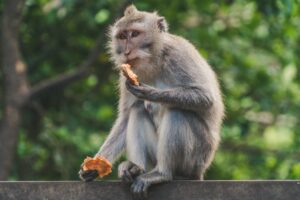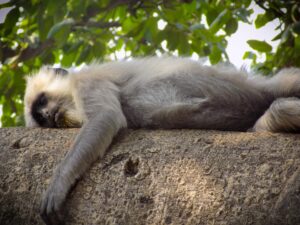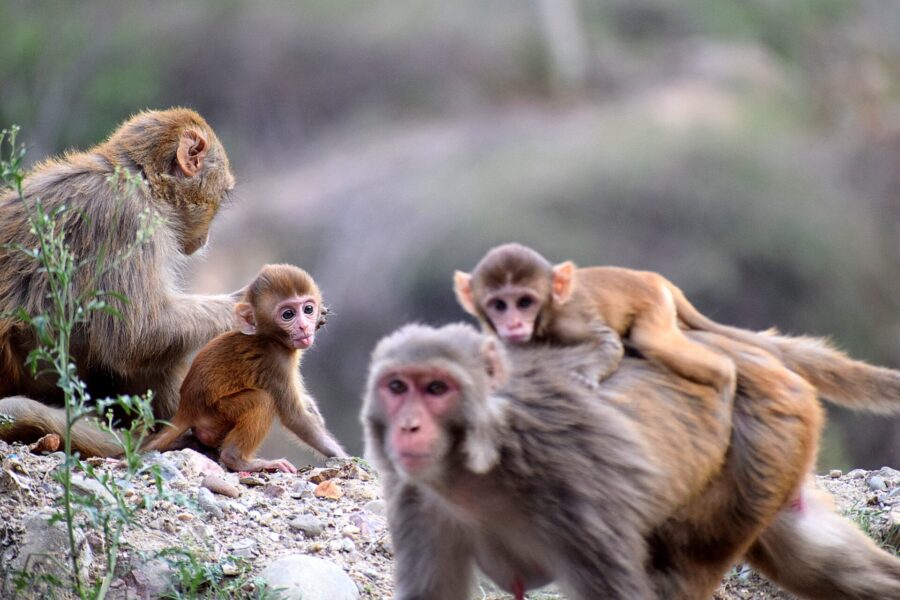Introduction:
Albino monkeys an ethereal spectacle in the animal kingdom, captivate the imagination with their rare appearance and intriguing characteristics. Nestled within the lush canopies of various habitats, these remarkable primates stand out not only for their snow-white fur and strikingly pale eyes but also for their enigmatic existence. In this exploration, we delve into the world of albino monkeys, shedding light on their rarity, unique traits, and the genetic intricacies underlying their ethereal appearance.
Despite their elusive nature, albino monkeys have garnered attention from wildlife enthusiasts and scientists alike for decades. Their scarcity in the wild sparks curiosity, prompting questions about their existence, prevalence, and the underlying genetic factors contributing to their distinctive appearance. Understanding the intricacies of these fascinating creatures not only unravels the mysteries surrounding their albinism but also sheds light on the delicate balance within ecosystems and the challenges they face in their natural habitats.
Are Albino Monkeys Rare?
Albino monkeys are undeniably rare creatures within their respective species. Encountering these astonishing primates in the wild is an exceptionally uncommon occurrence, often leaving observers in awe of their unique appearance. The rarity of albino monkeys stems from a combination of factors, primarily associated with genetic mutations and environmental influences.
Genetic Mutations and Rarity: At the core of their scarcity lies genetic mutations. Albinism, a genetic condition resulting in a lack of pigmentation in the skin, hair, and eyes, occurs when an individual inherits a set of mutated genes that prevent the body from producing normal amounts of melanin. In the case of albino monkeys, this lack of pigmentation gives rise to their distinct white fur and pale features.
The occurrence of albino individuals within primate populations is sporadic due to the recessive nature of the genes responsible for albinism. Both parents must carry and pass on specific genetic mutations for albinism to manifest in their offspring. Consequently, albino monkeys are born exceptionally rarely within their species, contributing to their elusive presence in the wild.
Environmental Influences: Beyond genetic predisposition, environmental factors also play a role in the rarity of albino monkeys. Their conspicuous appearance often makes them more vulnerable to predators, leading to decreased survival rates compared to their pigmented counterparts. This heightened vulnerability adds another layer of challenge to their existence in their natural habitats.
Documented Cases and Studies: While encounters with albino monkeys are infrequent, documented cases and studies offer glimpses into their prevalence across various primate species. Researchers have sporadically recorded and documented instances of albino monkeys in different parts of the world, providing valuable insights into their distribution and behavior.
Studies conducted on the prevalence of albino monkeys primarily rely on rare sightings or observations by scientists and wildlife enthusiasts. These studies serve as crucial references for understanding the frequency of albino individuals within specific primate populations and contribute to ongoing conservation efforts aimed at protecting these rare and vulnerable creatures.
Do Albino Monkeys Still Exist?
Yes, albino monkeys still exist, although their presence in the wild remains exceptionally rare. Despite their rarity, documented sightings and occasional observations by researchers and wildlife enthusiasts confirm their ongoing existence within certain primate populations across the globe.

Albino monkeys, while rare, have been observed and studied in various parts of the world. Here’s a breakdown highlighting their current existence, recent observations, and conservation efforts
Current Existence of Albino Monkeys in Different Parts of the World:
1. South America – Colombia:
In certain regions of Colombia, specifically within the rainforests, sightings of albino monkeys have been reported. These regions, rich in biodiversity, harbor populations of albino monkeys within species like capuchins and howler monkeys.
2. Asia – India and Southeast Asia:
Parts of India and Southeast Asia are home to various primate species, and sporadic observations of albino monkeys have been documented. Instances of albino langurs and macaques have been reported in areas like Assam, India, and parts of Thailand and Malaysia.
3. Africa – Guinea, West Africa:
In the forests of Guinea, West Africa, rare occurrences of albino chimpanzees have been observed. These observations provide crucial insights into the existence of albino individuals within chimpanzee populations.
What Are White Monkeys Called?
The terminology associated with white or albino monkeys can vary across different cultures and scientific communities. While there isn’t a universally accepted term specifically for albino monkeys, several terms have been used to refer to white or albino primates
Terminology Associated with Albino Monkeys:
1. Albino Monkeys:
The most straightforward term used in scientific contexts is “albino monkeys.” This term directly refers to primates with albinism, characterized by their lack of pigmentation resulting in white or very light-colored fur, skin, and eyes.
2. White Monkeys:
“White monkeys” is a general term used informally to describe primates exhibiting an unusually light or white-colored appearance. This term isn’t exclusive to albino individuals but may refer to primates with lighter pigmentation variations.
3. Leucistic Monkeys:
“Leucistic” refers to animals that have a partial loss of pigmentation. While not entirely albino, leucistic monkeys display paler colors than usual but may retain some pigmentation in certain areas.
4. Snow Monkeys:
Occasionally, the term “snow monkeys” might be used informally to describe primates with particularly white or light-colored fur. However, this term is often associated with a specific species called the Japanese macaque (Macaca fuscata) due to their adaptation to snowy habitats, rather than specifically denoting albinism.
Cultural and Scientific Variations:
Cultural perceptions and scientific communities may use distinct terms to describe albino or white monkeys:
- Local Indigenous Names: Indigenous cultures often have specific names for animals exhibiting unique features. For instance, some local tribes might have their own names or descriptions for albino monkeys based on their folklore, beliefs, or observations.
- Scientific Classification: Within scientific circles, albino monkeys may be classified based on their species and subspecies names alongside specific descriptors denoting their unique pigmentation, such as “albino capuchin” or “albino macaque.”
- Informal or Regional Terms: Depending on the region or community, informal terms may arise to describe albino monkeys. These terms might not have a standardized usage and could differ widely based on local dialects or common vernacular.
Characteristics of Albino Monkeys:
Here’s an overview of the characteristics of albino monkeys, including their physical attributes, unique traits, behavior, diet, and habitat preferences:
Physical Attributes of Albino Monkeys:
Fur and Skin:
- Albino monkeys exhibit a distinct lack of pigmentation, resulting in white or very pale fur, skin, and eyes.
- Their fur lacks the typical colors and patterns seen in non-albino members of the same species, often appearing uniformly white or light-colored.
- The skin of albino monkeys is typically sensitive to sunlight due to the absence of protective melanin.
Eyes:
- Albino monkeys commonly have pink or light-colored eyes due to the absence of pigment in the iris.
- Their eyes are sensitive to bright light and may display a lack of iris pigmentation, making the red-colored retina visible.
Unique Traits and Differences from Non-Albino Monkeys:
Vulnerability:
- Due to their lack of camouflage from their stark white appearance, albino monkeys are more vulnerable to predators in their natural habitats compared to their pigmented counterparts.
- Their heightened visibility makes them stand out, potentially leading to increased predation risk.
Behavioral Adaptations:
- Albino monkeys might exhibit certain behavioral adaptations, such as being more cautious or avoiding direct sunlight to protect their sensitive skin and eyes.
- They might display altered social behaviors within their groups, potentially due to their distinct appearance.
Behavior, Diet, and Habitat Preferences:
Behavior:
- Albino monkeys typically exhibit behaviors similar to their non-albino counterparts within their species, including social interactions, foraging, grooming, and communication.
- Their behavior might be influenced by their unique physical traits, affecting their interactions with the environment and other members of their group.
Diet:
- Their dietary preferences and feeding behaviors are consistent with the dietary habits of their species. They consume fruits, leaves, seeds, insects, and other food sources typical for their species.
Habitat Preferences:
- Albino monkeys inhabit the same habitats as their non-albino counterparts, including tropical rainforests, savannas, or wooded areas.
- However, due to their increased sensitivity to sunlight, they might seek shaded or densely vegetated areas within their habitat.
Challenges and Health Issues Associated with Albinism in Primates:
Sensitivity to Sunlight:

- Albino monkeys face challenges due to their sensitivity to sunlight. Their lack of melanin makes them susceptible to sunburn, skin damage, and increased risk of developing skin cancers.
Vision Impairment:
- The absence of pigmentation in the eyes affects the development of the retina, leading to reduced visual acuity and increased sensitivity to light.
- Albino monkeys might experience vision problems such as poor depth perception or nystagmus (involuntary eye movements).
Increased Predation Risk:
- Their stark white appearance makes albino monkeys highly visible to predators, resulting in a higher predation risk compared to their pigmented counterparts.
- This increased visibility poses a significant threat to their survival in the wild.
Conclusion:
Albino monkeys, with their unique genetic makeup and distinct physical traits, represent a rare and vulnerable aspect of primate diversity. Understanding and conserving these remarkable individuals are crucial steps in preserving biodiversity. By advocating for their protection, supporting conservation efforts, and fostering further research, we can ensure the survival of these captivating primates, contributing not only to their well-being but also to the broader preservation of our planet’s natural heritage.
